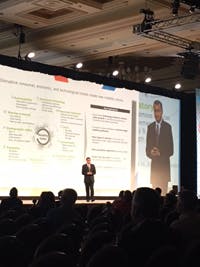LAS VEGAS — As the driver of the future and vehicle ownership models continue to change, there are opportunities for the aftermarket to maintain growth and succeed. However, those in the aftermarket must be willing to evolve as the industry evolves.
The four future states of mobility are: 1.) Personally owned autonomous vehicles; 2.) Shared autonomous vehicles; 3.) Personally owned, driver-driven vehicles; and 4.) Shared driver-driven vehicles.
These four states will coexist, and companies need to plan to compete in some or all of the states. Cost per mile economics and growth of consumption economies will be a driving force behind adoptions. Cost per mile could fall as much as two thirds due to increased utilization, reduced fuel consumption and other factors.
With personally-owned, driver-driven vehicles, it now costs about $1 per mile. But as you free up driver time and introduce shared-ownership concepts, cost drops significantly. This is driving the level of investment into these technologies.
“Our forecasts estimate an increase in total miles traveled, and a decline in overall vehicle sales, with faster shifts toward AVs and shared vehicles in urban centers,” Ganguli said. “The disruptive nature of this transformation results in massive shifts in economic value across a broad mobility ecosystem.”
There will be many shifts going forward beyond ownership scenarios. For example, the insurance market will have to adjust. Who owns the insurance liability in a vehicle sharing model, Ganguli asked. Parking revenue infrastructure and the airline industry will also be impacted, among others.
“We will need to think about how you are going to capture more revenue in a changing environment,” Ganguli said.
Future states will demand new types of vehicles with different content profiles. Personally-owned autonomous vehicles will offer luxury that is highly customized. And these customization options will give rise to new aftermarket segments and offerings.
Personally-owned, driver-driven vehicles will continue to develop and over time may shift toward more special-purpose vehicles that will increase the need for high-performance parts.
Shared autonomous vehicles may give rise to large fleets of no-frill, personal pods with safety and mobility being the main focuses. There will be a reduced demand for critical repair and high-performance parts, but an increased need for integration with infrastructure and consumer technology.
Shared, driver-driven vehicles will need consistent performance that will drive the need for lower repair costs. Increased vehicle use will drive wear and tear and boost demand for maintenance parts and will create a willingness to pay for durability.
There is opportunity going forward, but aftermarket companies may need to adjust their plans and models to meet the future demands of the drivers and fleets on the road.
There are hypotheses that touch on the implications for the aftermarket going forward:
- Transformation of in-vehicle content and services infrastructure as industry evolves toward electric, connected and autonomous vehicles
- Higher vehicle utilization in shared mobility drives more frequent parts maintenance and replacement and vehicle service needs
- Emergence of new B2B and B2C channels to accommodate new customer groups, accompanied by convergence across channels
- Increased access to end-consumer-triggered partnerships across value chains and OEM direct-to-consumer path
- Creation of new business models and revenue streams related to in-vehicle consumption as well as infrastructure enabling charging, mobility management
“This industry is really on the verge of huge value creation that we have not seen for decades. The question is, how do you play in these new opportunities that are going to be available to you?” Ganguli said. “While there are risks, the opportunities far outweigh the risks. These changes are happening. It is not a matter of if, but when.”


